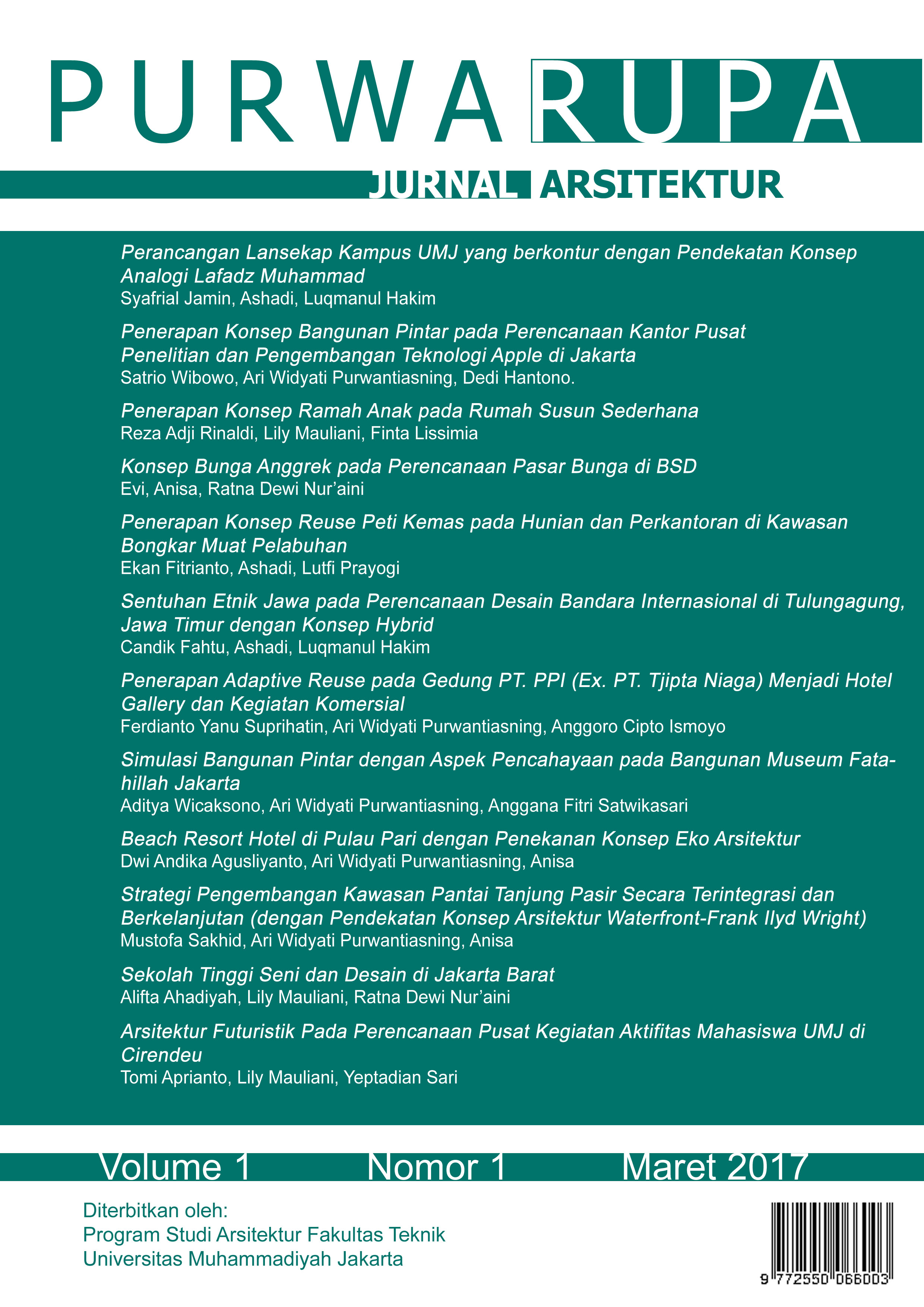STRATEGI PENGEMBANGAN KAWASAN PANTAI TANJUNG PASIR SECARA TERINTEGRASI DAN BERKELANJUTAN (DENGAN PENDEKATAN KONSEP ARSITEKTUR WATERFRONT- FRANK LLOYD WRIGHT)
DOI:
https://doi.org/10.24853/purwarupa.1.1.55-62Abstract
ABSTRAK. Fungsi wisata pada saat ini tidak lagi terbatas pada kegiatan santai/ piknik saja, akan tetapi dituntut untuk dapat menampung kegiatan lainnya, seperti rekreasi aktif, rekreasi pasif, hiburan, kontak sosial, acara adat dan sebagainya. Perencanaan dan Perancangan Pengembangan Kawasan Pantai Tanjung Pasir ini dimaksudkan untuk mendapatkan solusi perancangan dengan memanfaatan potensi alam secara maksimal dalam penataan tapak sebagai Kawasan Permukiman Nelayan dan Kawasan Wisata Laut. Penekanan konsep Arsitektur Waterfront Frank Lloyd Wright dilakukan dengan mengadopsi Desain Arsitektur Recreational Waterfront pada karakteristik desain massa dan bentuk bangunan kawasan waterfront yang menyediakan sarana dan prasarana untuk kegiatan rekreasi. Pembangunan diarahkan di sepanjang badan air dan tetap mempertahankan ruang terbuka, serta kekhasan arsitektur lokal yang dimanfaatkan secara komersial untuk menarik pengunjung. Perencanaan kawasan Tanjung Pasir merupakan integrasi antara zona wisata dengan zona permukiman nelayannya dan merupakan “bagian integral “ didalam pembangunan Kabupaten Tangerang. Kata Kunci : Pengembangan Kawasan, Pantai Tanjung Pasir, Permukiman Nelayan, Wisata Pantai, Integrasi, Waterfront ABSTRACT. Nowadays tourism is no longer limited to leisure activities/ picnic only, but must be able to accommodate other activities, such as active recreation, passive recreation, entertainment, social contact, the traditional activities as well as custom event. Planning and Design of Coastal Zone Development in Tanjung Pasir is aimed to find design solution by maximize natural potency in site planning as a Fisherment Settlement and Sea Tourism Area. The concept of Waterfront Architecture by Frank Lloyd Wright manifested by adopting Architectural Design Recreational waterfront on the design characteristics of the mass and shape of the building within waterfront area that provide facilities as well as infrastructures for recreational activitie. The area development directed along the beach while maintaining the presence of open space, as well as the peculiarities of local architecture that are commercially exploited in order to attract visitors. The planning of Tanjung Pasir area is an integration between tourism zone and fishermen’settlement and should be an "integral part" in the development of Tangerang regency. Keywords : Area Development, Tanjung Pasir Beach, Fishermen Settlement, Coast Tourism, Integration, WaterfrontDownloads
How to Cite
Issue
Section
License
COPYRIGHT POLICY
The author(s) of an article published in the Jurnal Teknologi retains ownership of the intellectual property rights in work (s).
PUBLISHING RIGHTS
The author(s) of an article published in the Jurnal Teknologi have unrestricted publication rights. The authors give the Jurnal Teknologi the right to publish the article and designate the Faculty of Engineering Universitas Muhammadiyah Jakarta Publishing as the original publisher of the article.
LICENSING POLICY
Journal of Mechanical Engineering and Sciences is an open-access journal that follows the Creative Commons Non-Commercial 4.0 International License (CC BY-NC 4.0), which states that:

Under this license, the reusers must give appropriate credit, provide a link to the license, and indicate if changes were made. Users may do so in any reasonable manner, but not in any way that suggests the licensor endorses users or their use.
Please take the time to read the whole license agreement (https://creativecommons.org/licenses/by-nc/4.0/). As long as reusers follow the license conditions, the owner cannot withdraw these freedoms. The following components are included under this license:
 Attribution: Users must provide appropriate attribution, including a link to the license, and indicate whether or not they made any modifications. Users are free to do so reasonably, but not in a manner that indicates the licensee approves of their usage.
Attribution: Users must provide appropriate attribution, including a link to the license, and indicate whether or not they made any modifications. Users are free to do so reasonably, but not in a manner that indicates the licensee approves of their usage.
 NonCommercial: Users may not use the material for commercial purposes.
NonCommercial: Users may not use the material for commercial purposes.

